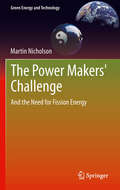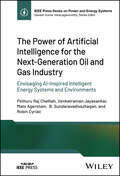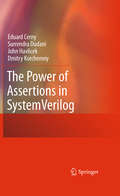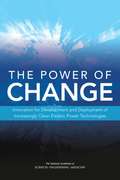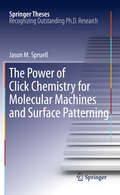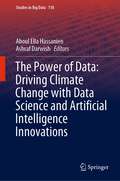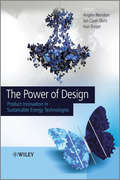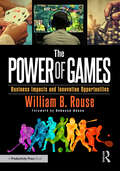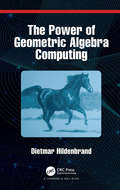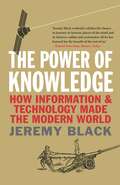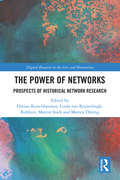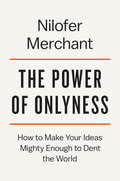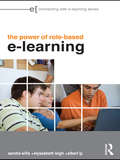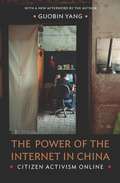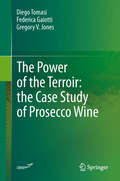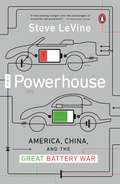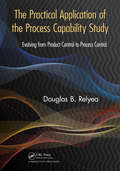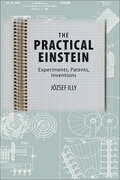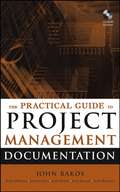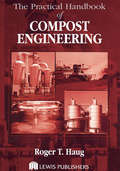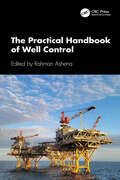- Table View
- List View
The Power Makers' Challenge
by Martin NicholsonThe Power Makers - the producers of our electricity - must meet the demands of their customers while also addressing the threat of climate change. There are widely differing views about solutions to electricity generation in an emission constrained world. Some see the problem as relatively straight forward, requiring deep cuts in emissions now by improving energy efficiency, energy conservation and using only renewable resources. Many electricity industry engineers and scientists see the problem as being much more involved. The Power Makers ' Challenge: and the need for Fission Energy looks at why using only conventional renewable energy sources is not quite as simple as it seems. Following a general introduction to electricity and its distribution, the author quantifies the reductions needed in greenhouse gas emissions from the power sector in the face of ever increasing world demands for electricity. It provides some much needed background on the many energy sources available for producing electricity and discusses their advantages and limitations to meet both the emission reduction challenge and electricity demand. By analyzing the three main groups of energy sources: renewable energy, fossil fuels and fission energy (nuclear power), readers can assess the ability of each group to meet the challenge of both reducing emissions and maintaining reliable supply at least cost. It is written for both non-technical and technical readers.
The Power Makers: Steam, Electricity, and the Men Who Invented Modern America
by Maury KleinIN 1800 AMERICA WAS AN AGRARIAN NATION, whose wealth came largely from the land and was extracted only with backbreaking toil. A century later, the country was an industrial superpower and the most advanced material society the world had ever seen. The Power Makers is the story of that transformation and of the dynamic, fiercely competitive men who made it happen. The steam engine, the incandescent lamp, the electric motor-inventions such as these replaced muscle power with machine labor, turned darkness to light, and reshaped every aspect of daily life in the span of a few generations. They were the product of an extraordinary cast of characters: dogged inventors like James Watt and Elihu Thomson; charismatic entrepreneurs like George Westinghouse; daring capitalists like Charles Coffin of General Electric and J. P. Morgan. Others include Samuel Insull, onetime assistant to Thomas Edison, who invented the modern utility business and brought power to millions, and Nikola Tesla, the eccentric Serbian immigrant whose revolutionary AC motor came to him in a vision. Striding among them like a colossus is the figure of Edison, who was creative genius and business visionary at once. With consummate skill, Maury Klein recreates their discoveries, their stunning triumphs and frequent failures, and their unceasing, bare-knuckled battles in the marketplace. Their personalities, and their fierce rivalries, leap off the page. The Power Makers is a saga of inspired invention, undaunted persistence, and business competition at its most naked and cutthroat- a dazzling tale of America in its most astonishing decades.
The Power of Artificial Intelligence for the Next-Generation Oil and Gas Industry: Envisaging AI-inspired Intelligent Energy Systems and Environments (IEEE Press Series on Power and Energy Systems)
by Pethuru Raj Chelliah Venkatraman Jayasankar Mats Agerstam B. Sundaravadivazhagan Robin CyriacThe Power of Artificial Intelligence for the Next-Generation Oil and Gas Industry Comprehensive resource describing how operations, outputs, and offerings of the oil and gas industry can improve via advancements in AI The Power of Artificial Intelligence for the Next-Generation Oil and Gas Industry describes the proven and promising digital technologies and tools available to empower the oil and gas industry to be future-ready. It shows how the widely reported limitations of the oil and gas industry are being nullified through the application of breakthrough digital technologies and how the convergence of digital technologies helps create new possibilities and opportunities to take this industry to its next level. The text demonstrates how scores of proven digital technologies, especially in AI, are useful in elegantly fulfilling complicated requirements such as process optimization, automation and orchestration, real-time data analytics, productivity improvement, employee safety, predictive maintenance, yield prediction, and accurate asset management for the oil and gas industry. The text differentiates and delivers sophisticated use cases for the various stakeholders, providing easy-to-understand information to accurately utilize proven technologies towards achieving real and sustainable industry transformation. The Power of Artificial Intelligence for the Next-Generation Oil and Gas Industry includes information on: How various machine and deep learning (ML/DL) algorithms, the prime modules of AI, empower AI systems to deliver on their promises and potential Key use cases of computer vision (CV) and natural language processing (NLP) as they relate to the oil and gas industry Smart leverage of AI, the Industrial Internet of Things (IIoT), cyber physical systems, and 5G communication Event-driven architecture (EDA), microservices architecture (MSA), blockchain for data and device security, and digital twins Clearly expounding how the power of AI and other allied technologies can be meticulously leveraged by the oil and gas industry, The Power of Artificial Intelligence for the Next-Generation Oil and Gas Industry is an essential resource for students, scholars, IT professionals, and business leaders in many different intersecting fields.
The Power of Assertions in SystemVerilog
by Surrendra Dudani Dmitry Korchemny Eduard Cerny John HavlicekThis book is the result of the deep involvementof the authors in the development of EDA tools, SystemVerilog Assertion standardization, and many years of practical experience. One of the goals of this book is to expose the oral knowhow circulated among design and veri?cation engineers which has never been written down in its full extent. The book thus contains many practical examples and exercises illustr- ing the various concepts and semantics of the assertion language. Much attention is given to discussing ef?ciency of assertion forms in simulation and formal veri?- tion. We did our best to validate all the examples, but there are hundreds of them and not all features could be validated since they have not yet been implemented in EDA tools. Therefore, we will be grateful to readers for pointing to us any needed corrections. The book is written in a way that we believe serves well both the users of SystemVerilog assertions in simulation and also those who practice formal v- i?cation (model checking). Compared to previous books covering SystemVerilog assertions we include in detail the most recent features that appeared in the IEEE 1800-2009 SystemVerilog Standard, in particular the new encapsulation construct “checker” and checker libraries, Linear Temporal Logic operators, semantics and usage in formal veri?cation. However, for integral understanding we present the assertion language and its applications in full detail. The book is divided into three parts.
The Power of Change: Innovation for Development and Deployment of Increasingly Clean Electric Power Technologies
by Engineering Medicine National Academies of SciencesElectricity, supplied reliably and affordably, is foundational to the U.S. economy and is utterly indispensable to modern society. However, emissions resulting from many forms of electricity generation create environmental risks that could have significant negative economic, security, and human health consequences. Large-scale installation of cleaner power generation has been generally hampered because greener technologies are more expensive than the technologies that currently produce most of our power. Rather than trade affordability and reliability for low emissions, is there a way to balance all three? The Power of Change: Innovation for Development and Deployment of Increasingly Clean Energy Technologies considers how to speed up innovations that would dramatically improve the performance and lower the cost of currently available technologies while also developing new advanced cleaner energy technologies. According to this report, there is an opportunity for the United States to continue to lead in the pursuit of increasingly clean, more efficient electricity through innovation in advanced technologies. The Power of Change: Innovation for Development and Deployment of Increasingly Clean Energy Technologies makes the case that America’s advantages—world-class universities and national laboratories, a vibrant private sector, and innovative states, cities, and regions that are free to experiment with a variety of public policy approaches—position the United States to create and lead a new clean energy revolution. This study focuses on five paths to accelerate the market adoption of increasing clean energy and efficiency technologies: (1) expanding the portfolio of cleaner energy technology options; (2) leveraging the advantages of energy efficiency; (3) facilitating the development of increasing clean technologies, including renewables, nuclear, and cleaner fossil; (4) improving the existing technologies, systems, and infrastructure; and (5) leveling the playing field for cleaner energy technologies. The Power of Change: Innovation for Development and Deployment of Increasingly Clean Energy Technologies is a call for leadership to transform the United States energy sector in order to both mitigate the risks of greenhouse gas and other pollutants and to spur future economic growth. This study’s focus on science, technology, and economic policy makes it a valuable resource to guide support that produces innovation to meet energy challenges now and for the future.
The Power of Click Chemistry for Molecular Machines and Surface Patterning
by Jason M. SpruellThe union of covalent and noncovalent chemistries manifested in the mechanical bond represents one of the great chemical triumphs of the last half century. However, until recently, the preparation of mechanically interlocked compounds has often been an inefficient and limiting process. This thesis provides a detailed account of the great strides taken to increase the synthetic accessibility of donor-acceptor mechanically interlocked molecules by the application of highly efficient and ultra mild chemical transformations during their template-directed synthesis. These new departures in synthesis have indeed played a transformative role in that more complex, higher-order, and functional architectures - once only a dream - are now comfortably within reach. Specifically, the formation of mechanical bonds in higher order rotaxanes and catenanes has become ever easier through the use of highly efficient click chemistries. The resulting mechanically interlocked compounds are functional molecular media for a host of applications including information storage, mechanical actuation, and drug release.
The Power of Data: Driving Climate Change with Data Science and Artificial Intelligence Innovations (Studies in Big Data #118)
by Ashraf Darwish Aboul Ella HassanienThis book discusses the advances of artificial intelligence and data sciences in climate change and provides the power of the climate data that is used as inputs to artificial intelligence systems. It is a good resource for researchers and professionals who work in the field of data sciences, artificial intelligence, and climate change applications.
The Power of Design
by Han Brezet Jan Carel Diehl Angèle H. ReindersThe Power of Design offers an introduction and a practical guide to product innovation, integrating the key topics that are necessary for the design of sustainable and energy-efficient products using sustainable energy technologies.Product innovation in sustainable energy technologies is an interdisciplinary field. In response to its growing importance and the need for an integrated view on the development of solutions, this text addresses the functional principles of various energy technologies next to the latest design processes and innovation methods.From the perspective of product applications, the book provides clear explanations of technologies that are significant for product integration, such as batteries, photovoltaic solar energy, fuel cells, small wind turbines, human power, energy saving lighting, thermal energy technologies in buildings, and piezoelectric energy conversions. The design processes and innovation methods presented in this book include various approaches ranging from technical, societal and creative methods that can be applied in different stages of the design process. Other features include: a methodological approach, enabling readers to easily apply the theory to their research projects and to the actual design of sustainable products with energy technologiesdiscussion on interaction design and smart grid interventionscolour photographs that illustrate the final productsnumerous case studies of product development projects and concepts in practice, enabling readers to understand and design energy-efficient products in several different marketsa companion website containing useful information about the cases and an additional design cases with sustainable energy technologies The Power of Design provides a comprehensive and visually-appealing opening into the subject for third and fourth year students, postgraduates, and professionals in the areas of energy, environment, product design and engineering
The Power of Games: Business Impacts and Innovation Opportunities
by William B RouseGames have long played a central role in society – actually a central role in the animal kingdom. Their play provides primary behavioral mechanisms that enable animals to learn and socialize. Indeed, "play" is a core animal activity. The principal focus of this book is on how games foster human playing, learning, and competing, including how we can design games to do this better. The author provides a wealth of real-world examples of how he created games for clients in the domains of education, energy, healthcare, national security, and transportation. He has focused on training and aiding for strategic thinking, product planning, technology development, and business operations. The technologies underlying these games became increasingly sophisticated. This has taken on greater significance as the gaming industry has grown and prospered. Gaming revenues now dwarf film and theater. New games released gain millions of sales within a few days of release. What makes games so appealing? What is the psychology of gaming? Does it vary for card games, board games, simulation games, and online games? What makes a game successful over years? What about sports games? What sociological roles do they play in our society? Why do they claim such energy and devotion? Why are sports stars able to earn enormous contracts? What is the business of these games? Why is it expected to be increasingly lucrative? What strategies might succeed or fail? Who might be the losers and winners? This book addresses all of these questions as well as an overarching question for society – Can online games fundamentally enhance the education of employees and students? The author is convinced they can. This requires, however, that games be designed to achieve these ends. This book is intended to contribute to understanding how to create and evaluate such games. Essentially, games enable employees and managers to play, learn, compete, and achieve in terms of knowledge and skills gained, competencies attained, customers attracted, and economic outcomes. This book explains, illustrates, and motivates investments in these pursuits to these ends.
The Power of Geometric Algebra Computing: For Engineering and Quantum Computing
by Dietmar HildenbrandGeometric Algebra is a very powerful mathematical system for an easy and intuitive treatment of geometry, but the community working with it is still very small. The main goal of this book is to close this gap from a computing perspective in presenting the power of Geometric Algebra Computing for engineering applications and quantum computing. The Power of Geometric Algebra Computing is based on GAALOPWeb, a new user-friendly, web-based tool for the generation of optimized code for different programming languages as well as for the visualization of Geometric Algebra algorithms for a wide range of engineering applications. Key Features: Introduces a new web-based optimizer for Geometric Algebra algorithms Supports many programming languages as well as hardware Covers the advantages of high-dimensional algebras Includes geometrically intuitive support of quantum computing This book includes applications from the fields of computer graphics, robotics and quantum computing and will help students, engineers and researchers interested in really computing with Geometric Algebra.
The Power of Knowledge
by Jeremy Blackwhile providing important indicators for the future of our world.
The Power of Networks: Prospects of Historical Network Research (Digital Research in the Arts and Humanities)
by Florian Kerschbaumer Linda von Keyserlingk-Rehbein Martin Stark Marten DüringThe Power of Networks describes a typology of network-based research practices in the historical disciplines, ranging from the use of quantitative network analysis in cultural, economic, social or political history or religious studies, to novel approaches in the Digital Humanities. Network data visualisations and calculations have proven to be useful tools for the analysis of mostly textual sources containing relational information, offering new perspectives on complex historical phenomena. Including case studies from antiquity to contemporary history, the book provides a clear demonstration of the opportunities historical network research (HNR) provides for historical studies. The examples presented within the pages of this volume are arranged in a way to highlight three central typological pillars of HNR: (re-)construction and analysis of historical networks; computational extraction of network data and infrastructures for data collection and exploration. The Power of Networks outlines the history and current state of research in HNR and points towards future research frontiers in the wake of new digital technologies. As such, the book should be essential reading for academics, students and practitioners with an interest in digital humanities, history, archaeology and religion.
The Power of One: How I Found the Strength to Tell the Truth and Why I Blew the Whistle on Facebook
by Frances HaugenThe inside story of one woman&’s quest to bring transparency and accountability to Big Tech, by the Facebook whistleblower who is determined to help us all retake control of our lives. In 2021, when news outlets feasted on &“the Facebook Files,&” Frances Haugen went public as the former employee who blew the whistle on the company by copying tens of thousands of pages of documents. She testified to Congress and spoke to the media. She was hailed at President Biden&’s first State of the Union Address. She made sure everyone understood exactly what the documents revealed: Facebook knew it had accidentally changed its algorithm to reward extremism and refused to fix it; it knew that its customers were using the platform to foment violence, to spread falsehoods, to diminish the self-esteem of young women, and more. But how was it that Haugen was the only employee at the company who dared to step forward? The answer to that question is an inspiring tale of one young woman&’s life and the choices she made. From an isolated childhood in Iowa to an unaccredited college, to one among the few women at Google in its heyday, Frances Haugen learned how to focus on what mattered, and to ignore her critics. To harness the strength of standing in the truth. The Power of One is equally inspiring—the story of a woman who went against the grain, again and again, and changed the world—and horrifying, as the culture and practices of Facebook are brought into the bright light of day, for the first time.
The Power of Onlyness: Make Your Wild Ideas Mighty Enough to Dent the World
by Nilofer Merchant“For any would-be activists who hear the voice: ‘not me’ or ‘not now,’ Merchant makes the strong case for ‘yes you’ and ‘yes now’—and even shows you how to jump in.” —Van Jones, host of CNN’s The Messy Truth, author of Rebuild the Dream and The Green Collar EconomyAn innovation expert illuminates why your power to make a difference is no longer bound by your statusIf you’re like most people, you wish you had the ability to make a difference, but you don’t have the credentials, or a seat at the table, can’t get past the gatekeepers, and aren’t high enough in any hierarchy to get your ideas heard.In The Power of Onlyness, Nilofer Merchant, one of the world’s top-ranked business thinkers, reveals that, in fact, we have now reached an unprecedented moment of opportunity for your ideas to “make a dent” on the world. Now that the Internet has liberated ideas to spread through networks instead of hierarchies, power is no longer determined by your status, but by “onlyness”—that spot in the world only you stand in, a function of your distinct history and experiences, visions and hopes. If you build upon your signature ingredient of purpose and connect with those who are equally passionate, you have a lever by which to move the world. This new ability is already within your grasp, but to command it, you need to know how to meaningfully mobilize others around your ideas. Through inspirational and instructive stories, Merchant reveals proven strategies to unleash the centrifugal force of a new idea, no matter how weird or wild it may seem. Imagine how much better the world could be if every idea could have its shot, not just the ones that come from expected people and places. Which long-intractable problems would we solve, what new levels of creativity would be unlocked, and who might innovate a breakthrough that could benefit ourselves, our communities, and especially our economy. This limitless potential of onlyness has already been recognized by Thinkers 50, the Oscars of management, which cited it one of the five ideas that will shape business for next twenty years.Why do some individuals make scalable impact with their ideas, regardless of their power or status? The Power of Onlyness unravels this mystery for the first time so that anyone can make a dent. Even you.
The Power of Role-based e-Learning: Designing and Moderating Online Role Play (Connecting with E-learning)
by Elyssebeth Leigh Sandra Wills Albert IpWritten for educators seeking to engage students in collaboration and communication about authentic scenarios, The Power of Role-Based e-Learning offers helpful, accessible advice on the practice and research needed to design online role play. Drawing on the experiences of world-leading practitioners and citing an array of worldwide examples, it is a readable, non-technical, and comprehensive guide to the design, implementation, and evaluation of this exciting teaching approach. Issues discussed include: designing effective online role plays defining games, simulations and role plays moderating engaging and authentic role-based e-learning activities assessment and evaluation. The Power of Role-Based e-Learning offers a careful analysis of the strengths and learning opportunities of online role play, and is realistic about possible difficulties. Providing guidance for both newcomers and experienced professionals who are developing their online teaching repertoire, it is an invaluable resource for teachers, trainers, academics, and educational support staff involved in e-learning.
The Power of Video Technology in International Comparative Research in Education
by Board on International Comparative Studies in EducationInformation on The Power of Video Technology in International Comparative Research in Education
The Power of the Internet in China: Citizen Activism Online (Contemporary Asia in the World)
by Guobin YangSince the mid-1990s, the Internet has revolutionized popular expression in China, enabling users to organize, protest, and influence public opinion in unprecedented ways. Guobin Yang's pioneering study maps an innovative range of contentious forms and practices linked to Chinese cyberspace, delineating a nuanced and dynamic image of the Chinese Internet as an arena for creativity, community, conflict, and control. Like many other contemporary protest forms in China and the world, Yang argues, Chinese online activism derives its methods and vitality from multiple and intersecting forces, and state efforts to constrain it have only led to more creative acts of subversion. Transnationalism and the tradition of protest in China's incipient civil society provide cultural and social resources to online activism. Even Internet businesses have encouraged contentious activities, generating an unusual synergy between commerce and activism. Yang's book weaves these strands together to create a vivid story of immense social change, indicating a new era of informational politics.
The Power of the Terroir: the Case Study of Prosecco Wine
by Diego Tomasi Federica Gaiotti Gregory V. JonesThis book draws on an eight-year study carried out in the DOCG Prosecco area of Italy, a wine region known worldwide. It is unique in the sense that it is based on one of the most comprehensive investigations into terroir zoning ever performed in Italy. By drawing attention to the complex interrelations between environmental and human factors that influence the growth and production of the Glera grape, the study illustrates the distinct correlation between a wine and its 'terroir'. It shows that the morphology of the sites, the meso and microclimate, the soil, the grapevine planting density, the trellising system, the yield of the vineyard, and the vine water status in the summer lead to unique combinations of grape maturity, acidity, and aroma that ultimately influence the sensory properties of the wines produced. Furthermore, the book details numerous technical and agronomic considerations, specific to the "Glera" grape variety, for different production strategies, including a section on the impact of climate change on cv "Glera" phenology. "The Power of the Terroir: the Case Study of Prosecco Wine" represents a valuable resource for anyone involved in studies or research activities in the fields of viticulture, climatology, agronomic sciences or soil sciences, but is also of interest to vine growers, professionals in the wine industry, and wine enthusiasts in general.
The Powerhouse
by Steve LevineA Soul of a New Machine for our time, a gripping account of invention, commerce, and duplicity in the age of technologyA worldwide race is on to perfect the next engine of economic growth, the advanced lithium-ion battery. It will power the electric car, relieve global warming, and catapult the winner into a new era of economic and political mastery. Can the United States win?Steve LeVine was granted unprecedented access to a secret federal laboratory outside Chicago, where a group of geniuses is trying to solve this next monumental task of physics. But these scientists-- almost all foreign born--are not alone. With so much at stake, researchers in Japan, South Korea, and China are in the same pursuit. The drama intensifies when a Silicon Valley start-up licenses the federal laboratory's signature invention with the aim of a blockbuster sale to the world's biggest carmakers.The Powerhouse is a real-time, two-year thrilling account of big invention, big commercialization, and big deception. It exposes the layers of competition and ambition, aspiration and disappointment behind this great turning point in the history of technology.From the Hardcover edition.
The Powerhouse: Inside the Invention of a Battery to Save the World
by Steve LevineA Soul of the New Machine for our time, a gripping account of invention, commerce, and duplicity in the age of technology... A worldwide race is on to perfect the next engine of economic growth, the advanced lithium-ion battery. It will power the electric car, relieve global warming, and catapult the winner into a new era of economic and political mastery. Can the United States win?Steve LeVine was granted unprecedented access to a secret federal laboratory outside Chicago, where a group of geniuses is trying to solve this next monumental task of physics. But these scientists-- almost all foreign born--are not alone. With so much at stake, researchers in Japan, South Korea, and China are in the same pursuit. The drama intensifies when a Silicon Valley start-up licenses the federal laboratory's signature invention with the aim of a blockbuster sale to the world's biggest carmakers. The Powerhouse is a real-time, two year thrilling account of big invention, big commercialization, and big deception. It exposes the layers of competition and ambition, aspiration and disappointment behind this great turning point in the history of technology.
The Practical Application of the Process Capability Study: Evolving From Product Control to Process Control
by Douglas B. RelyeaThis book shows readers how to use the process capability study to increase return on investment from their statistical process control/Six Sigma effort and make their company more competitive. It provides benefits to every department within a manufacturing organization.
The Practical Einstein: Experiments, Patents, Inventions
by József IllyThis unique biography of the famous theoretical physicist explores his work in the practical worlds of technology, engineering and experimental physics.Albert Einstein is known as the whacky genius behind the theory of relativity, but that’s just one facet of his contribution to modern science and human knowledge. As József Illy demonstrates in this book, Einstein had an eminently practical side as well.As a youth, Einstein was an inveterate tinkerer in the electrical supply factory owned by his father and uncle. His first paid job was as a patent examiner. He consulted on industrial patent cases and worked on technological innovations, most notably the gyrocompass. Later in life, Einstein contributed to many inventions, including refrigerators, microphones, and instruments for aviation. His published papers often provided ways to test his theories, and he also wrote explanations for common natural phenomena, such as the meandering of rivers.In these and other hands-on examples culled from the Einstein Papers, Illy demonstrates how Einstein enjoyed leaving the abstract world of theories to wrestle with the problems of everyday life.A Choice Magazine Outstanding Academic Title
The Practical Guide to Project Management Documentation
by Steve Jackson Scott Kennedy James Harris John Rakos Laverne Fleck Karen DhanrajProject Management The one-stop resource for project management documentation and templates for all projects The success of any project is crucially dependent on the documents produced for it. The Practical Guide to Project Management Documentation provides a complete and reliable source of explanations and examples for every possible project-related document-from the proposal, business case, and project plan, to the status report and final post-project review. The Practical Guide to Project Management Documentation is packed with material that slashes the time and effort expended on producing new documents from scratch. Following the processes in the Project Management Institute's Project Management Body of Knowledge (PMBOK(r)), this one-stop, full-service book also offers tips and techniques for working with documents in each project process. Documentation for several project/client scenarios is addressed, including internal and externally contracted projects. A single project-the construction of a water theme park-is used as the case study for all the document examples. An included CD-ROM provides all the documents from the book as Microsoft Word(r) files. Readers can use these as a framework to develop their own project documents. The Practical Guide to Project Management Documentation is an unmatched reference for the numerous documents essential to project managers in all industries.
The Practical Handbook of Compost Engineering
by RogerTim HaugThe Practical Handbook of Compost Engineering presents an in-depth examination of the principles and practice of modern day composting. This comprehensive book covers compost science, engineering design, operation, principles, and practice, stressing a fundamental approach to analysis throughout. Biological, physical, chemical, thermodynamic, and kinetic principles are covered to develop a unified analytical approach to analysis and an understanding of the process. A brief history of the development of composting systems, which leads to descriptions of modern processes, is presented. The Practical Handbook of Compost Engineering also discusses the elements of successful odor management at composting facilities, including state-of-the-art odor treatment and enhanced atmospheric dispersion. The book is excellent for all engineers, practitioners, plant operators, scientists, researchers, and students in the field.
The Practical Handbook of Well Control
by Rahman AshenaThe Practical Handbook of Well Control teaches readers to safeguard well safety and integrity in drilling well engineering. Offering an applied and scientific point of view, it covers fundamental aspects of well control and includes practical procedures and well control methods for land and offshore operations. It features a wealth of questions to commonly encountered problems and comprehensive answers at the end of each topical discussion to test reader comprehension. Written in a concise, accessible way by experienced oilfield and academic experts Covers all related technical subjects of well control Describes modern aspects of well control, including automatic well control, advances in outflow measurement, artificial intelligence and IoT techniques for early kick detection, mud gas separators, and riser gas modeling Includes case studies to familiarize readers with real-world problems and solutions Offers a full explanation of each problem to familiarize readers with commonly faced issues Features sample exercises with comprehensive answers useful for IWCF and IADC exams This handbook serves as a valuable reference and workbook for field drilling and workover engineers in the energy sector.
